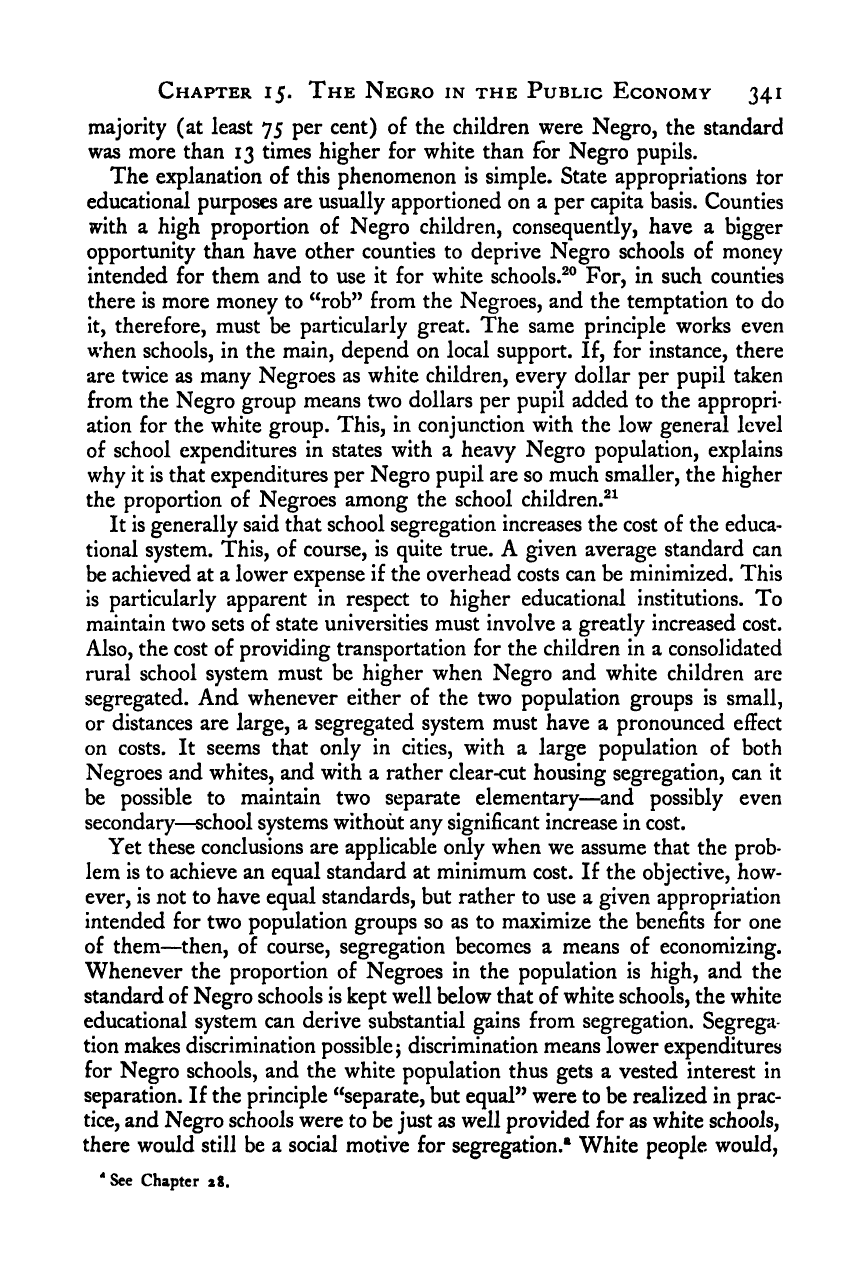Note: Gunnar Myrdal died in 1987, less than 70 years ago. Therefore, this work is protected by copyright, restricting your legal rights to reproduce it. However, you are welcome to view it on screen, as you do now. Read more about copyright.
Full resolution (TIFF) - On this page / på denna sida - IV. Economics - 15. The Negro in the Public Economy - 3. Education

<< prev. page << föreg. sida << >> nästa sida >> next page >>
Below is the raw OCR text
from the above scanned image.
Do you see an error? Proofread the page now!
Här nedan syns maskintolkade texten från faksimilbilden ovan.
Ser du något fel? Korrekturläs sidan nu!
This page has never been proofread. / Denna sida har aldrig korrekturlästs.
Chapter 15. The Negro in the Public Economy 341
majority (at least 75 per cent) of the children were Negro, the standard
was more than 13 times higher for white than for Negro pupils.
The explanation of this phenomenon is simple. State appropriations tor
educational purposes are usually apportioned on a per capita basis. Counties
with a high proportion of Negro children, consequently, have a bigger
opportunity than have other counties to deprive Negro schools of money
intended for them and to use it for white schools.^® For, in such counties
there is more money to ^^rob” from the Negroes, and the temptation to do
it, therefore, must be particularly great. The same principle works even
when schools, in the main, depend on local support. If, for instance, there
are twice as many Negroes as white children, every dollar per pupil taken
from the Negro group means two dollars per pupil added to the appropri-
ation for the white group. This, in conjunction with the low general level
of school expenditures in states with a heavy Negro population, explains
why it is that expenditures per Negro pupil are so much smaller, the higher
the proportion of Negroes among the school children.^^
It is generally said that school segregation increases the cost of the educa-
tional system. This, of course, is quite true. A given average standard can
be achieved at a lower expense if the overhead costs can be minimized. This
is particularly apparent in respect to higher educational institutions. To
maintain two sets of state universities must involve a greatly increased cost.
Also, the cost of providing transportation for the children in a consolidated
rural school system must be higher when Negro and white children are
segregated. And whenever either of the two population groups is small,
or distances are large, a segregated system must have a pronounced effect
on costs. It seems that only in cities, with a large population of both
Negroes and whites, and with a rather clear-cut housing segregation, can it
be possible to maintain two separate elementary—and possibly even
secondary—school systems without any significant increase in cost.
Yet these conclusions are applicable only when we assume that the prob-
lem is to achieve an equal standard at minimum cost. If the objective, how-
ever, is not to have equal standards, but rather to use a given appropriation
intended for two population groups so as to maximize the benefits for one
of them—then, of course, segregation becomes a means of economizing.
Whenever the proportion of Negroes in the population is high, and the
standard of Negro schools is kept well below that of white schools, the white
educational system can derive substantial gains from segregation. Segrega-
tion makes discrimination possible j
discrimination means lower expenditures
for Negro schools, and the white population thus gets a vested interest in
separation. If the principle “separate, but equal” were to be realized in prac-
tice, and Negro schools were to be just as well provided for as white schools,
there would still be a social motive for segregation.® White people would,
<< prev. page << föreg. sida << >> nästa sida >> next page >>